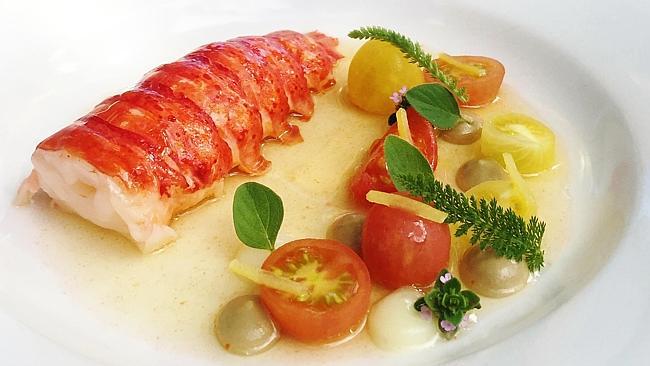Flavour of the month: marron with tomatoes at Cullen Wines
The idea behind Colin Anderson’s marron dish comes from the tomato salad his mum used to eat.

The idea behind Colin Anderson’s marron dish comes from the tomato salad his mum used to eat.
The dish: Pemberton marron with baby tomatoes, green olive, lemon, oregano and yarrow with tomato water.
Backstory: Cullen chef Colin Anderson’s first job was on a 21m lobster boat that worked out of a tiny island off the west coast of his native Scotland. “We caught lobsters, brown crabs, velvet crabs and langoustines. I did this during school holidays from the age of 11 until I was 15 and loved it,” says Anderson, who moved to Wilyabrup, in Western Australia’s Margaret River region, last year from Sydney, where he worked at Quay.
“I loved seeing the live shellfish and learning from Duncan the fisherman how to prepare, cook and serve them, often with a simple tomato salad,” he says. “At that point I didn’t like eating seafood and it’s safe to say that’s one of my regrets in life.” That has changed.
“Although marron are freshwater crustaceans, from the first time I saw and tasted marron — their blue-tinged shells, soft and super-sweet meat — they reminded me of those lobsters we caught so many years ago,” Anderson says. “Not as richly flavoured as Scottish lobster but sweeter and more delicate, which is a perfect match for the luscious tomatoes from the biodynamic Cullen gardens.”
The idea behind Anderson’s dish comes from the tomato salad his mum used to eat, with local lobster and the inspirational garden at Cullen Wines. “I really wanted to create a dish which showcased the simple tomato but also a dish which speaks volumes about how much we grow and use here. All the dishes on the menu are designed to work with the wines produced here. Clean, pure flavours of produce grown biodynamically, allowing the energy from the land to grow the best possible ingredients to work in harmony with the wines grown in the same way, from the same soil. Something I believe really is quite unique.”
Produce: Everything in the dish except marron, salt, vinegar and sugar is from the Cullen garden. The marron is from Blue Ridge Marron in Western Australia’s southwest. They are two to three years old at the stage Colin buys them and weigh about 200g each, delivered live.
Method: The marron is cooked in sea-salty water and peeled to order, dressed with a little olive oil and salt. The tomatoes are blowtorched, peeled and dressed with oregano, then dressed with oregano-infused Cullen olive oil, sugar and salt.
Estate-grown olives are stoned and blended with olive oil and a touch of xanthan gum to create an emulsion. Preserved lemon skin is sliced into thin strips; the rest of the lemon is halved, seeds removed, blanched and refreshed six times, then cooked until tender in a syrup of two parts water, one part sugar, then blitzed until smooth. Both these emulsions dot the plate. Oregano flowers and leaves are used to garnish, along with young, tender yarrow “ferns”.
The twist: The fresh flavours of marron, tomato and lemon come together nicely with the addition of chilled tomato water made with fresh tomatoes, oregano, thyme, garlic, balsamic vinegar, sugar and salt. With 48 hours and filtration, it is added at the table.
The price: Given the cost of marron, a menu price of $28 reflects the care and effort that goes into a dish with unique produce and is something of a West Australian flag-bearer. And if it seems pricey, the estate wines at Cullen are a bargain, and to drink them in situ a joy.
Other terrific marron dishes: Poached marron with a burnt butter emulsion and a salad of raw marron meat, fingerlime and saltbush at Wildflower, Perth; fermented baby cucumber with a just-set, charcoal-grilled marron in crustacean butter at Igni, Geelong; wood-grilled whole marron with fingerlime and native herbs at Firedoor, Sydney.
